Course
What is dbt and why is it important?
For the past few years, the data science community has been slowly accepting data-centric paradigms. Instead of increasingly complex machine learning models, we are finally focusing more on data quality. This gave rise to the massive popularity of data engineers. They are now earning salaries only given to skilled data scientists or ML engineers.
And one tool that has significantly made data engineers’ lives better is dbt (data build tool). Its purpose is to introduce the battle-tested software engineering best practices to data engineering and produce data value as quickly and easily as possible.
This article will cover the fundamentals of dbt for entry-level data engineers seeking to add an indispensable tool to their belt. You can also check out our Introduction to dbt course to learn more about this powerful tool.
Prerequisites
Only a few for this article:
- Basic to intermediate SQL: if you know how to use the WHERE and GROUP BY clauses, you are good to go.
- Familiarity in the terminal: comfort with the terminal, virtual environments and installing software with package managers like pip or homebrew are all necessary.
- Basics of data warehouses: fundamental knowledge of data engineering is a giant plus. It shouldn’t be necessarily deep like you know Kimball’s four step process but enough to understand some of the key terms.
If you can’t meet these criteria and yet, and your boss (or yourself) still requires you to learn dbt, you can use the following resources:
What Will This dbt Guide Cover?
The open-source community loves dbt, so they managed to integrate it with nearly every tool that works with data. The result? A documentation so massive that even the quick start guides are larger than the docs of entire Python libraries.
So, my goal with this article is to introduce you to seven core concepts of dbt with moderate technicality sprinkled in-between. After finishing the tutorial, you can go to any page of dbt docs and figure out what is going on.
Now, let’s dive right into it!
Become a Data Engineer
Must-know dbt Concepts
0. Data warehouse
On of the prerequisite concepts you'll need to know is that of a data warehouse. A warehouse is where you store all data that belongs to some company.
Companies build warehouses because they enable analytics and everything else you can do with data (ahem, structured data). They store historical data organized into tables, and they are structured for fast querying and analysis.
There are many tools that implement data warehouses:
- PostgreSQL
- MySQL
- Snowflake
- BigQuery
- Redshift
and so on.
dbt doesn’t help you collect or load data into the above tools but transform their data within. In other words, it does the T in the ETL/ELT process (extraction, transformation, load) that is at the heart of all warehouses.
1. dbt Core vs. dbt Cloud
dbt is offered through two interfaces: dbt Core and dbt Cloud.
dbt Core is an open-source library that implements most of the functionality of dbt. It has a command-line interface (the dbt command you will come to love) that you can use to manage data transformations in your projects.
dbt Cloud is an enterprise solution for teams. On top of the CLI, dbt Cloud also provides a more user-friendly web-based IDE. With it, you don’t have to worry about database connections and editing YAML files so much (as you will see in the coming sections).
dbt Cloud also offers additional features like job scheduling, advanced integrations and high priority support.
Here is a table summarizing the differences between dbt Core and dbt Cloud:
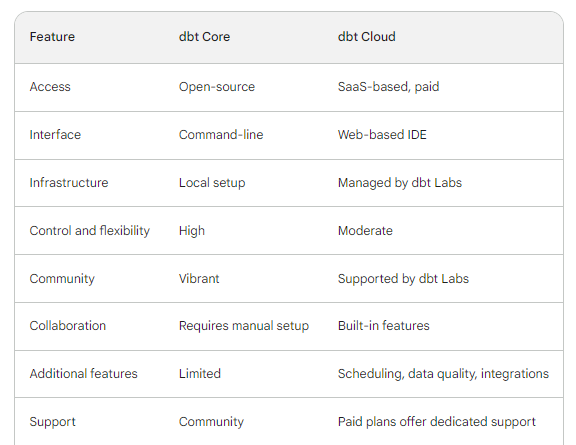
Despite the additional features, we will cover dbt Core as it is best suited for local projects, testing and learning. You can install it with pip on any OS (inside a virtual environment, of course).
I will use a Conda environment:
$ conda create -n learn_dbt -y
$ pip install dbt-<adapter_name>
You should replace adapter_name with the database you want to use. dbt Labs (the company behind dbt) has integrated many adapters for different data platforms.
In this article, we will use the dbt-duckdb adapter to connect to a DuckDB database. But you can use any of the adapters listed on this page of dbt docs.
$ pip install dbt-duckdb
That’s it for initial setup!
2. dbt Projects
Basically, a dbt project is a directory on your machine containing everything required to perform transformations on your data. It contains lots of .sql files (called models) and YAML files (for configurations).
To create a dbt project, you can use the dbt init <project_name> command on the CLI:
$ dbt init dbt_learnThe terminal asks you to enter a code that corresponds to your available data platform adapters. Since you only have DuckDB, you can press 1.
$ cd dbt_learn
Inside dbt_learn, you have the following structure:
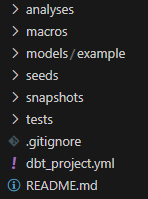
This is where data engineers become software engineers because dbt projects let you:
- Organized and modular: keep your data transformations organized and separated into manageable units, making your code easier to understand and maintain.
- Version control: track changes and revert to previous versions of your models, ensuring data consistency and reproducibility.
- Collaboration: add multiple users who can work on the same project with defined roles and permissions.
- Testable: write tests for your models to ensure they work as expected and identify potential issues before deploying them to production.
- Repeatable: use the same project for consistent data transformations across different data sources and environments.
In short, dbt projects offer a powerful way to manage and orchestrate data transformations. They bring the long-awaited benefits of software engineering to the data world.
3. dbt Project Profiles
We’ve initialized a dbt project and now, we need to connect to an existing database (or create one from scratch). To do this, we need a secure way to feed database credentials to dbt to establish a connection. This is where we will use a project profile.
A project profile is a YAML file containing the connection details for your chosen data platform. The file itself is created in the .dbt directory in $HOME and is named profiles.yml. Here is what it looks like, right now:
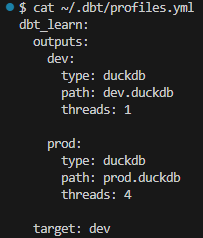
The file lists a single profile named dbt_learn for our project. It specifies two outputs: dev and prod.
Outputs are individual configurations that specify different connections to data warehouses or databases. Through outputs, you can manage connections to different environments:
- Development
- Testing
- Production and so on.
In our profile, our default output is dev, which is listed in the target field. You can change it to any other output based on your needs. For now, we leave it as it is.
Note: you can change the profile and output names as long as they are correctly referenced in the rest of the dbt files.
The path field specifies the location of an existing database called dev.duckdb. If it doesn't exist, it will be created by the dbt DuckDB adapter in our working directory (inside dbt_learn project; the path field specifies relative paths to the project directory). Since we don't have a database called dev.duckdb, we will let dbt create it by running dbt debug.
$ dbt debug
The debug sub-command is used to test many aspects of the project such as:
- Errors in
profiles.ymlfile - Database connection details in
profiles.yml - The database adapter
- Errors in
dbt_project.ymlfile and so on.
If you received a green “All tests passed” message and a new dev.duckdb database appeared, then you are good to go.
4. dbt Models
Models are at the heart of dbt as they represent the actual transformations dbt is famous for.
A data model is a conceptual idea that represents the structure and relationships within a set of data. Data models in dbt are simpler and more specific. They have the following attributes:
- Represent a data transformation (like performing a cleaning operation)
- Typically written with SQL in
.sqlfiles (Python is allowed in newer versions of dbt) - Usually consists of one SELECT query
Our dbt_learn project comes pre-populated with two dummy models inside models/example:
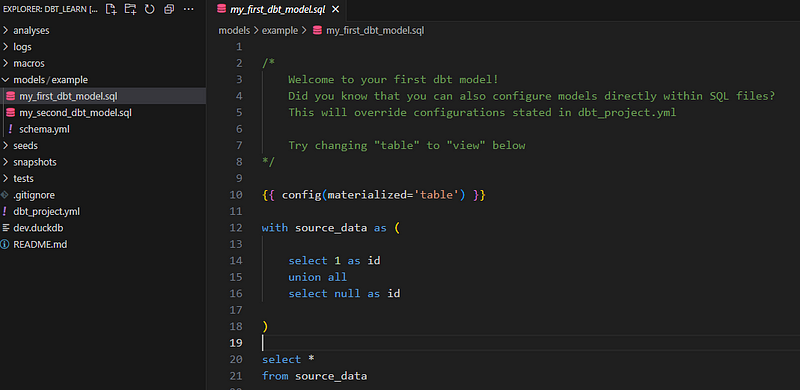
We will delete them and create our own:
$ rm -rf models/example
$ mkdir models/stats
$ touch models/stats/average_diamond_price_per_group.sql
In the last line of the above code snippet, we are creating a model named average_diamond_price_per_group inside stats directory. It is important to be descriptive in model names.
Inside the model (.sql file), paste this dummy test SQL query:
SELECT 1 AS Id
and run the model with dbt run:
$ dbt run
You should receive a green “Completed successfully” message.
After everything is set up, we can load some data into our dev.duckdb database. We will use a parquet file to do so, as DuckDB natively supports them.
SELECT AVG(price), cut
FROM "diamonds.parquet"
GROUP BY cut
The query should return the same success message.
For this tutorial, I’ve prepared the diamonds dataset as a parquet file. In this GitHub gist, you can find the snippet to download it to your workspace.
We’ve just seen how to create our first dbt model by using a SELECT statement that returns some summary statistics about a dataset. In practice, your models will depend on your business requirements and how different employees work with your database. Therefore, we won’t focus on the actual logic of dbt models but on how to implement them correctly.
5. DAGs in dbt
In a real-world project, your models will most likely be dependent on each other, forming some kind of hierarchy. In the data world, this hierarchy is called a Direct Acyclic Graph (DAG) or a lineage graph.
A single DAG can do the job of a 1000-word documentation. Take a look at this example from the dbt DAGs page:
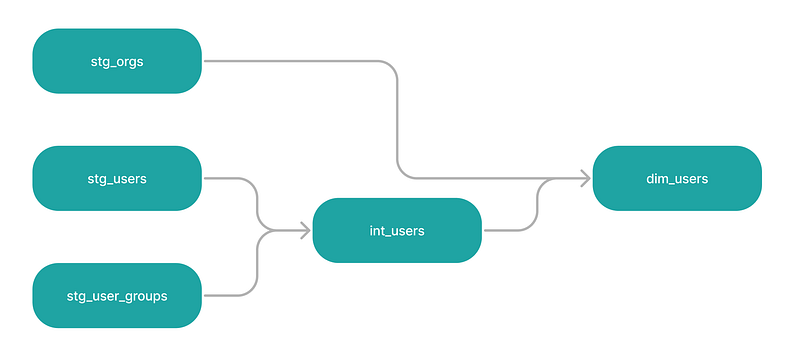
There are four models in this graph, all linearly connected to models downstream. stg_users and stg_user_groups are parent models of int_users, which, in turn, is a parent model of dim_users together with stg_orgs model upstream.
Note: the words upstream and downstream are frequently used to refer to the relative position of each model in the DAG.
One key aspect of DAGs is that there are no closed loops. This means that a downstream model, which is the result of earlier models, cannot be joined with an upstream model. That’s where the word acyclic comes from.
Apart from the visual richness of DAGs, their purpose is letting dbt build/update models according to their dependencies. If we don’t define a DAG for the four models above, dbt will build them in alphabetical order. This would result in all kinds of red messages and errors.
To define a DAG in dbt, we will use Jinja templating.
6. Jinja Templating in dbt
In the above DAG, int_users model is the product of stg_users and stg_user_groups. We need to specify this relationship in our project, otherwise dbt run executes all models alphabetically, which means int_users goes first. This will result in an error as its dependencies are not yet materialized.
Right now, int_users model may look like this:
SELECT some_column
FROM stg_users as su
JOIN stg_user_groups as sug
ON su.a = sug.a
Now, we will link the three models by turning them into nodes of a DAG using Jinja:
SELECT some_column
FROM {{ ref("stg_users") }} as su
JOIN {{ ref("stg_user_groups" )}} as sug
ON su.a = sug.a
Instead of writing the model names directly, we are putting them inside a Jinja function called ref. The syntax is {{ ref("column_name") }} (mind the spaces and the quotes). When our query is compiled, the Jinja function is substituted with the actual model name.
Note that stg_users and stg_user_groups should exist as .sql files in your dbt project.
Now, when we execute dbt run, it will look for the dependencies of each model, connect them and execute them accordingly.
The ref function in Jinja isn't the only one we can use in dbt. In fact, by using Jinja's other functions and features, you can significantly expand the functionality of your SQL statements. Here are some examples:
- Use Jinja to create variables in model files:
{% set status = 'active' %} -- Define a variable
SELECT *
FROM customers
WHERE status = {{ status }};
- Define variables in model configuration files using the config object.
If we have models/model_properties.yml file and it has the following fields:
# models/model_properties.yml
version: 2
models:
- name: my_model
config:
target_schema: analytics
We can access its fields inside any .sql file using Jinja:
{% set target_schema = config.target_schema %}
CREATE TABLE {{ target_schema }}.{{ target_table }} AS
...
- Use conditionals and loops (what a surprise this was!):
Conditionals:
{% if some_condition %}
SELECT * FROM test_data
{% else %}
SELECT * FROM production_data
{% endif %}
Loops:
SELECT
order_id,
{% for payment_method in ["bank_transfer", "credit_card", "gift_card"] %}
SUM(CASE WHEN payment_method = '{{ payment_method }}' THEN amount END) AS {{ payment_method }}_amount,
{% endfor %}
SUM(amount) AS total_amount
FROM {{ ref('raw_payments') }}
GROUP BY 1;
- Create functions in SQL (macros) through Jinja (no, I am not kidding):
Here is the macro:
{% macro create_table(table_name, columns) %}
CREATE TABLE {{ table_name }} (
{% for column in columns %}
{{ column.name }} {{ column.type }},
{% endfor %}
);
{% endmacro %}
And here is how you can use it in models:
{% call create_table('my_customer_table', [
{'name': 'id', 'type': 'integer'},
{'name': 'name', 'type': 'varchar(255)'},
{'name': 'email', 'type': 'varchar(255)'},
]) %}
INSERT INTO {{ my_customer_table }} (id, name, email)
SELECT customer_id, customer_name, customer_email
FROM raw_customers;
If you want to learn more about using Jinja in dbt with SQL, check this page of dbt docs.
7. dbt Tests
Now, a good software developer knows that they need to test their code constantly for bugs and errors. Since dbt turns data engineers into software developers, it offers them a straightforward workflow to use tests, both built-in and custom.
Currently, dbt offers the following four built-in tests:
unique- verify all values are uniquenot_null- check missingaccepted_values- verify all values are within a specified list, has avaluesargumentrelationships- verifies a connection to a specific table or column, hastoandfieldarguments
To specify which tests to use on which columns, we use a YAML file called model_properties.yml inside the models directory.
Note: model_properties.yml is not a requirement for models to run and it can be named anything. But, if you want to create tests to validate the data feeding into your models through tests, this file is a must.
Let’s see how to use the not_null test to check for missing values in the cut column of the diamonds table. First, create a model_properties.yml file inside models:
$ touch models/model_properties.yml
Inside, paste the following contents:
version: 2
models:
- name: average_diamond_price_per_group
columns:
- name: cut
tests:
- not_null
In the - name field under models, we are specifying which model we are defining properties for. Then, we specify the column and its name. Finally, we write the tests field, under which we list the not_null test.
Now, you can use this test to perform data validation before running dbt run. The command is dbt test:
$ dbt test
If you receive an error message, it means the test failed and you need to examine the issue in the table and fix it if necessary.
A Typical dbt Workflow You Can Follow
To use dbt successfully in your projects, you can use this recommended workflow:
1. Project initialization
- Install
dbtand create a new project withdbt init
2. Configuration
- Choose a database platform for your project
- Configure the database credentials in
profiles.ymlin your home directory. - Adjust project settings: Modify
dbt_project.ymlfor project-level settings (e.g., version, dependencies).
3. Development
- Write model SQL code: Create
.sqlfiles in themodelsdirectory for model definitions. - Write model tests: Create
.ymlfiles in thetestsdirectory for test definitions. - Test incrementally: Use
dbt testto run tests frequently during development. - Debug issues: Use
dbt debugfor troubleshooting.
4. Local Validation (topics we didn’t cover)
- Build project: Use dbt build to compile models and tests.
- Run thorough tests: Execute all tests using dbt test.
Additional best practices:
- Version control: Use Git for collaboration and version control (this is a must).
- Documentation: Write human-readable comments in models and tests. You can use
dbt docs generateto render the docs of models in a web server (yes, that's possible) later. - Profiling: Utilize dbt’s profiling capabilities to catch and fix performance bottlenecks.
- Continuous integration (CI): Integrate dbt with CI/CD pipelines for automated testing and deployment.
Conclusion and further resources
We have covered many fundamentals in this tutorial, but as I mentioned way back in the beginning, dbt is a massive tool with many features. It will take you a while to master it to the level that you can comfortably use it in production environments. Why not use these resources to help you achieve that goal faster?
Get certified in your dream Data Engineer role
Our certification programs help you stand out and prove your skills are job-ready to potential employers.

I am a data science content creator with over 2 years of experience and one of the largest followings on Medium. I like to write detailed articles on AI and ML with a bit of a sarcastıc style because you've got to do something to make them a bit less dull. I have produced over 130 articles and a DataCamp course to boot, with another one in the makıng. My content has been seen by over 5 million pairs of eyes, 20k of whom became followers on both Medium and LinkedIn.


